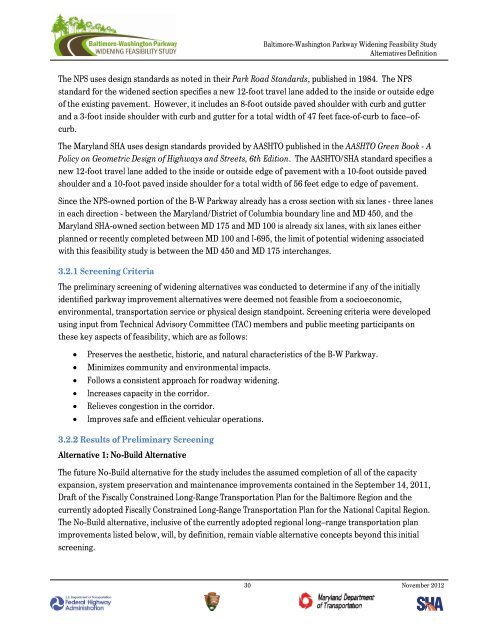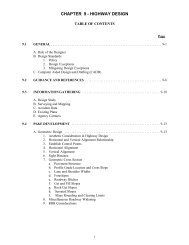Baltimore-Washington Parkway Widening Feasibility Study
Baltimore-Washington Parkway Widening Feasibility Study
Baltimore-Washington Parkway Widening Feasibility Study
- No tags were found...
Create successful ePaper yourself
Turn your PDF publications into a flip-book with our unique Google optimized e-Paper software.
<strong>Baltimore</strong>-<strong>Washington</strong> <strong>Parkway</strong> <strong>Widening</strong> <strong>Feasibility</strong> <strong>Study</strong>Alternatives DefinitionThe NPS uses design standards as noted in their Park Road Standards, published in 1984. The NPSstandard for the widened section specifies a new 12-foot travel lane added to the inside or outside edgeof the existing pavement. However, it includes an 8-foot outside paved shoulder with curb and gutterand a 3-foot inside shoulder with curb and gutter for a total width of 47 feet face-of-curb to face–ofcurb.The Maryland SHA uses design standards provided by AASHTO published in the AASHTO Green Book - APolicy on Geometric Design of Highways and Streets, 6th Edition. The AASHTO/SHA standard specifies anew 12-foot travel lane added to the inside or outside edge of pavement with a 10-foot outside pavedshoulder and a 10-foot paved inside shoulder for a total width of 56 feet edge to edge of pavement.Since the NPS-owned portion of the B-W <strong>Parkway</strong> already has a cross section with six lanes - three lanesin each direction - between the Maryland/District of Columbia boundary line and MD 450, and theMaryland SHA-owned section between MD 175 and MD 100 is already six lanes, with six lanes eitherplanned or recently completed between MD 100 and I-695, the limit of potential widening associatedwith this feasibility study is between the MD 450 and MD 175 interchanges.3.2.1ScreeningCriteriaThe preliminary screening of widening alternatives was conducted to determine if any of the initiallyidentified parkway improvement alternatives were deemed not feasible from a socioeconomic,environmental, transportation service or physical design standpoint. Screening criteria were developedusing input from Technical Advisory Committee (TAC) members and public meeting participants onthese key aspects of feasibility, which are as follows:Preserves the aesthetic, historic, and natural characteristics of the B-W <strong>Parkway</strong>.Minimizes community and environmental impacts.Follows a consistent approach for roadway widening.Increases capacity in the corridor.Relieves congestion in the corridor.Improves safe and efficient vehicular operations.3.2.2ResultsofPreliminaryScreeningAlternative 1: No-Build AlternativeThe future No-Build alternative for the study includes the assumed completion of all of the capacityexpansion, system preservation and maintenance improvements contained in the September 14, 2011,Draft of the Fiscally Constrained Long-Range Transportation Plan for the <strong>Baltimore</strong> Region and thecurrently adopted Fiscally Constrained Long-Range Transportation Plan for the National Capital Region.The No-Build alternative, inclusive of the currently adopted regional long–range transportation planimprovements listed below, will, by definition, remain viable alternative concepts beyond this initialscreening.30 November 2012
















